Niko Pirosmani
ნიკო ფიროსმანი | |
|---|---|
 Pirosmani, 1916 | |
| Born | Nikoloz Aslanis Dze Pirosmanashvili 5 May 1862 Mirzaani, (Georgia) |
| Died | 9 April 1918 (aged 55) |
| Nationality | Georgian |
| Education | Self-taught |
| Known for | Painting |
| Movement | Naïve art |
| Signature | |
.svg.png.webp) | |
Nikoloz (Niko) Pirosmanashvíli (Georgian: ნიკოლოზ (ნიკო) ფიროსმანაშვილი) was a Georgian naïve art painter.
Biography

Pirosmani was born in the Georgian village of Mirzaani to a peasant family in modern-day Kakheti region. His parents, Aslan Pirosmanashvili and Tekle Toklikishvili, were farmers, who owned a small vineyard, with a few cows and oxen. He was later orphaned and left in the care of his two elder sisters, Mariam and Pepe. He moved with them to Tbilisi in 1870. Pirosmani gradually taught himself to paint. One of his specialties was painting directly into black oilcloth. In 1882, with self-taught George Zaziashvili, he opened a painting workshop, where they made signboards. In 1890, he worked as a railroad conductor. In 1893, he co-founded a dairy farm in Tbilisi, which he left in 1901. Throughout his life, Pirosmani, who was poor, was willing to take ordinary jobs including housepainting and whitewashing buildings. He also worked for shopkeepers in Tbilisi, creating signboards, paintings, and portraits, according to their orders. Although his paintings had some local popularity (about 200 survive) his relationship with professional artists remained uneasy; making a living was always more important to him than aesthetic abstractions.
In April 1918, he died in the 1918 flu pandemic as a result of malnutrition and liver failure. He was buried at the Nino cemetery; the exact location was not registered and is unknown.
Work
Pirosmani's paintings were influenced by the social conditions of his time and place. There are many works about merchants, shopkeepers, workmen, and noblemen groups. Pirosmani was fond of nature and rural life. He rarely employed city landscapes. He made many animal paintings. He was the only Georgian animalist. Pirosmani also was attracted by historical figures and themes such as Shota Rustaveli, Queen Tamar, Giorgi Saakadze, as well as ordinary Georgian people and their everyday lives.
Usually, Pirosmani painted on oilcloth. Unlike other artists, Niko didn't aim at a pure imitation of the nature and paid no attention to details. Some of his paintings are monochrome. His paintings demonstrate the author's sharp compositional consideration. Placements of the figures are frontal, while faces do not demonstrate a specific mood.
Posthumous reputation

After his death, Pirosmani gained international reputation when he became admired as a 'naïve' painter in Paris and elsewhere. His paintings were represented at the first big exhibition of Georgian painters in 1918. From 1920 onwards, a number of articles were published about him. The first monograph on Pirosmani was published in 1926 in Georgian, French and Russian.
Interest in Pirosmani increased in the 1950s.

In 1969, a film about him was made, titled Pirosmani. He inspired a portrait sketch by Pablo Picasso (1972). Pirosmani is also depicted on a Georgian lari bill (although this bill is rarely seen in circulation today, since 1 lari coins are far more common). A periodic newspaper titled Pirosmani is published in two languages in Istanbul. In 1983 Edward Kuznetsov produced the first catalogue raisonné on Pirosmani's work, entitled Niko Pirosmani, 1862-1918[1].
Exhibitions of his work have been held in Kyiv (1931), Warsaw (1968), Paris (The Louvre) (1969), Vienna (1969), Nice and Marseilles (1983), Tokyo (1986), Zurich (1995), Nantes (1999), Turin (2002), Kyiv, Istanbul (2008), Minsk, Vézelay and Vilnius (2008–2009), Vienna again (2018–19)[2] and Basel (Foundation Beyeler) (2023–2024).[3]
Today, 146 of his works are shown in the Art Museum of Georgia and sixteen paintings are exhibited in the Historical-Ethnographic Museum of Sighnaghi. A monument was installed in Tbilisi. There is also the Niko Pirosmanashvili Museum in Mirzaani, Georgia, in one of his abodes.[4]
Recent discoveries
In March 2011, it was discovered that the writing on the door of Qvrivishvilebi's wine-cellar in Ozaani was made by Pirosmani. On 31 May 2011, during an investigation, experts discovered a painting, which proved to be "Wounded Soldier" by Pirosmani. The painting was given to the National Gallery of Georgia.
Paintings
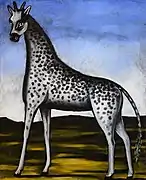 Giraffe, 1900s, Art Museum of Georgia
Giraffe, 1900s, Art Museum of Georgia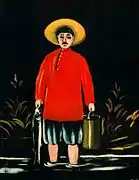 A Fisherman, 1900s, Art Museum of Georgia
A Fisherman, 1900s, Art Museum of Georgia The actress Margarita, 1909, Art Museum of Georgia
The actress Margarita, 1909, Art Museum of Georgia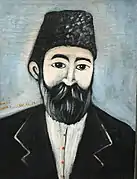 Self-portrait, 1900, Private collection
Self-portrait, 1900, Private collection Iranian Lion, from 1862 until 1918, Art Museum of Georgia
Iranian Lion, from 1862 until 1918, Art Museum of Georgia A Peasant Woman with Children Going to Fetch Water, 1900s, Art Museum of Georgia
A Peasant Woman with Children Going to Fetch Water, 1900s, Art Museum of Georgia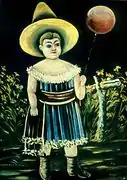 Little Girl with a Balloon, 1900s, Art Museum of Georgia
Little Girl with a Balloon, 1900s, Art Museum of Georgia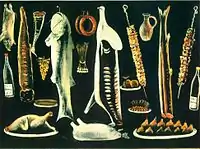 Still-Life, 1900s, Art Museum of Georgia
Still-Life, 1900s, Art Museum of Georgia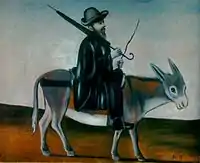 Healer on a Donkey, 1900s, Sighnaghi Museum
Healer on a Donkey, 1900s, Sighnaghi Museum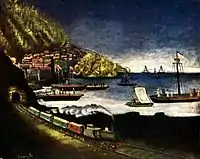 Batumi port, 1900s, Art Museum of Georgia
Batumi port, 1900s, Art Museum of Georgia Black Lion, 1905
Black Lion, 1905._Oil_on_oilcloth._130X105_cm._Private_collection.jpg.webp) A Georgian Woman with Tamboreen / Georgian woman with Lechaki, 1910s, Private collection
A Georgian Woman with Tamboreen / Georgian woman with Lechaki, 1910s, Private collection Meezove-Janitor, 1909, Art Museum of Georgia
Meezove-Janitor, 1909, Art Museum of Georgia A Doe against Landscape (Stag), 1913, Art Museum of Georgia
A Doe against Landscape (Stag), 1913, Art Museum of Georgia.jpg.webp) White Cow on a Black Background, 1915, Private collection
White Cow on a Black Background, 1915, Private collection
Footnotes
- ↑ Kuznetsov, Edward (1983). Niko Pirosmani, 1862 - 1918. Leningrad: Aurora. ISBN 978-0569088527.
- ↑ "Niko Pirosmani". Albertina Wien (in German). Retrieved 21 December 2018.
- ↑ "Niko Pirosmani 17 September 2023 – 28 January 2024". Foundation Beyeler. 2023. Retrieved 23 September 2023.
- ↑ "Niko Pirosmanashvili museum in Mirzaani". www.georgianholidays.com. Retrieved 21 December 2018.
References
- Georgian National Museum, Niko Pirosmani 1862-1918, Tbilisi, 2006. No ISBN.
- «Пиросмани», Э Кузнецов, 1975, Искусство.
- «Легенда о Пиросмани», Валериан Маркаров, 2018
External links
![]() Media related to Niko Pirosmani at Wikimedia Commons
Media related to Niko Pirosmani at Wikimedia Commons
- Official website
- Biography and Works of Pirosmani at the Wayback Machine (archived November 23, 2007)
- Biography
- Olga's Gallery: Niko Pirosmani
- A bilingual (Turkish and Georgian) quarterly journal, called Pirosmani is published in Istanbul.
- A contemporary art gallery that exhibits international emerging artists working in painting, photography, glass, ceramics and sculpture called Pirosmani in Istanbul.